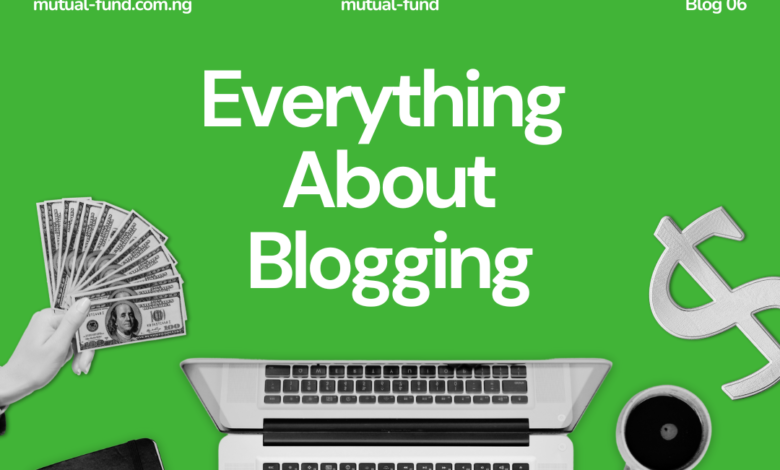
Imagine having a platform to share your thoughts, connect with like-minded individuals, and even build a thriving online presence. That’s the power of blogging. It’s more than just an online diary, it’s a dynamic tool for self-expression, community building, and potential income generation. Whether you’re passionate about cooking, technology, travel, or anything in between, this blogpost guide will walk you through everything you need to know to launch and grow a successful blog.
WHAT IS A BLOG?
A blog is like an online journal or magazine where individuals or groups share their thoughts, experiences, and information on a particular topic. It’s a platform for self-expression, community building, and knowledge sharing.

WHY IS BLOGGING A GOOD BUSINESS?
Do you know why Blogging is one of the best online businesses to start in 2025?
Blogging no de ask for certificate. If you wake up today and decide to be a blogger, take the steps in our last post and update your bio, my dear, you are a blogger.
To start from scratch, you do not need a big budget, just hard work and consistency. ANYONE can become a blogger, no prior experience required. You don’t even need to be a graduate, with tools like ChatGPT, half of your work is already done.
Infact, if you take your own blog seriously and you’re able to start getting consistent organic traffic, I assure you that people will pay you to manage their own websites for them.
There are a lot of opportunities available in the blogging sphere and I know we are all trying to get rich quick. However, if you decide to take the short cut, it is also the road with the most risk and it requires A LOT of capital.
Have you chosen your niche yet?
Turn Your Passion into Profit: Do you love traveling, fitness, tech, or personal finance? You can actually make your blog about that. Just make sure to search trends that would attract traffic.
Start updating your websites daily and gathering that organic traffic, you never can tell who is watching and where your big break will come.
HOW TO GET STARTED IN BLOGGING?
Getting started in Blogging has to do with you building a solid foundation and the foundation is Niche ,selecting a blogging platform, and setting up your blog. Stay chill up while i take you on how to get you started in blogging.
- Choosing your Niche: Your niche is the specific topic or area of focus for your blog. It’s important to choose a niche that you’re passionate about and knowledgeable in. This will make creating content enjoyable and sustainable in the long run. Consider your interests, skills, and experiences. What are you naturally attracted to? What do people ask you for advice on? What do you spends time on?
Once you have a few ideas, research their profitability and audience interest. Are there other blogs in this niche? Is there a demand for information on this topic? Tools like Google Keyword Planner can help you gauge search volume and identify potential audience interest. Some examples of niches include sustainable living, minimalist lifestyle, personal finance for millennials, indie game reviews, or even a very specific type of cooking.
2. Picking a Blogging Platform:
Your blogging platform is the software you’ll use to create and manage your blog. There are several options available.
- Blogger (Self-Hosted): This is the most popular blogging platform, offering unparalleled flexibility and control. However, it requires you to find your own web hosting and handle technical aspects like installation and updates. While it may seem daunting at first, the vast community and abundance of resources make it relatively easy to learn.
- WordPress.com: This is a simpler, hosted version of WordPress. It’s easier to set up than WordPress.org, but it comes with limitations in terms of customization and monetization.
- Other Platforms: Platforms like Wix, Squarespace, Medium, and Blogger offer user-friendly interfaces and easy setup. However, they often have limited functionality and less control compared to WordPress.org.
For beginners, especially those serious about growing their blog long-term, blogger is generally the recommended choice.
3. Setting Up Your Blog:
- Choose a Domain Name: Your domain name is your blog’s address on the internet (e.g., www.yourblogname.com). Choose a name that is memorable, relevant to your niche, and easy to spell.
- Find a Web Hosting Provider: Your web hosting provider stores your blog’s files and makes it accessible online. Look for a reputable provider with good customer support and reliable uptime.
- Install WordPress: Most hosting providers offer one-click WordPress installation, making this process incredibly simple.
- Choose a Theme: A theme controls the look and feel of your blog. You can choose from thousands of free and premium themes. Make sure your theme is responsive (mobile-friendly) and visually appealing.
- Essential Plugins: Plugins are add-ons that extend the functionality of your blog. Essential plugins include those for SEO (Yoast SEO), security (Wordfence), and caching (WP Super Cache).

Section 2: Creating Compelling Blog Content
Content is the heart and soul of your blog. Creating high-quality, engaging content is essential for attracting and retaining readers.
Understanding Your Audience:
Before you start writing, it’s crucial to understand your target audience. Who are you writing for? What are their interests, needs, and pain points? Creating reader personas can help you visualize your ideal reader and tailor your content accordingly.
Content Headlines and Topics:
Content headlines are the core themes of your blog. They represent the main topics you’ll be covering. Brainstorm blog post ideas within these content pillars. Keyword research is essential for identifying topics that people are searching for. Use tools like Google Keyword Planner, Ahrefs, or Semrush to find relevant keywords and long-tail keywords (more specific phrases).
Writing Engaging Blog Posts:
- Compelling Headlines: Your headline is the first thing people see, so make it count. Use strong verbs, numbers, and emotional words to grab attention.
- Structure: Structure your posts with a clear introduction, body, and conclusion. Use headings, subheadings, bullet points, and white space to make your content easy to read.
- Language: Use clear, concise language that your audience can understand. Avoid jargon and technical terms unless your audience is familiar with them.
- Storytelling: Incorporate stories and personal anecdotes to make your content more relatable and engaging.
- Visuals: Use high-quality images, videos, and infographics to break up the text and add visual interest.
- Readability: Optimize your content for readability by using short paragraphs, bullet points, and plenty of white space.
Section 3: Promoting Your Blog and Building an Audience
Creating great content is only half the battle. You also need to promote your blog and build an audience.
Search Engine Optimization (SEO) Basics:
SEO is the process of optimizing your blog and content to rank higher in search engine results pages (SERPs). This involves on-page optimization (optimizing your content), off-page optimization (building backlinks), and technical SEO (ensuring your site is technically sound).
I’ll be talking about search engine optimization in my next blog post. Watch Out guys.
Social Media Marketing:
Social media platforms are great for promoting your blog and connecting with potential readers. Choose the platforms that are most relevant to your niche and create engaging content to share.
Email Marketing:
Building an email list is crucial for nurturing your audience and driving traffic to your blog. Offer lead magnets (e.g., free eBooks, checklists) in exchange for email addresses.
Guest Blogging:
Guest blogging involves writing articles for other blogs in your niche. It’s a great way to gain exposure, build backlinks, and reach a wider audience.
Community Engagement:
Engage with your readers by responding to comments on your blog and participating in relevant online communities.
Section 4: Monetizing Your Blog
Once you have a decent amount of traffic, you can start exploring ways to monetize your blog.
- Affiliate Marketing: Promote other companies’ products or services and earn a commission on each sale.
- Display Advertising: Place ads on your blog and earn money based on clicks or impressions.
- Selling Products or Services: Create and sell your own digital products (e.g., eBooks, courses) or offer consulting services.
- Sponsored Posts: Partner with brands to create sponsored content.
HERE IS A VIDEO GUIDE TO HELP YOU KICKSTART YOUR BLOGGING CAREER. WATCH THIS VIDEO.
Conclusion
Blogging is a journey, not a destination. It takes time, effort, and dedication to build a successful blog. Don’t be discouraged if you don’t see results overnight. Keep creating great content, promoting your blog, and engaging with your audience. The rewards of blogging, from personal fulfillment to potential income, are well worth the effort. So, take the step, start your blog today, and share your voice with the world. See you on the next one.
